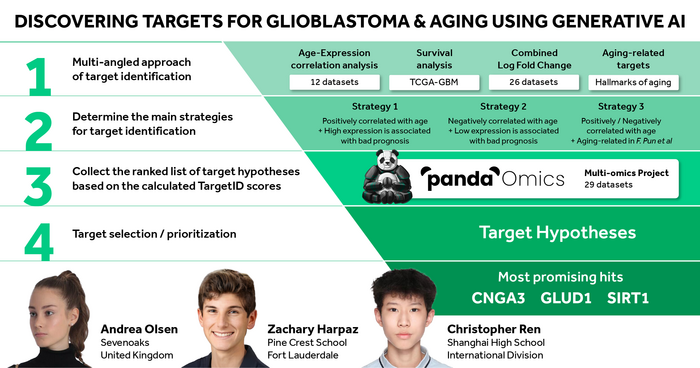
Andrea Olsen from Oslo, Norway; Zachary Harpaz from Boca Raton, Florida; and Chris Ren from Shanghai, China co-authored a paper using Insilico Medicine's PandaOmics AI target discovery system to uncover three potential targets for glioblastoma and aging. Image Credit: Insilico Medicine
PandaOmics is used to determine new therapeutic targets for glioblastoma multiforme (GBM). GBM is known to be the most hostile and common malignant brain tumor, thereby accounting for 16% of all main brain tumors.
The study outcomes were reported in the journal Aging on April 26th, 2023.
Olsen, a student at Sevenoaks School in Kent, UK, started interning at Insilico Medicine in 2021 after finding her interest in neurobiology and technology.
For the present paper, which is the fifth scientific paper she has co-authored before turning eighteen, she and other scientists utilized PandaOmics to screen datasets from the Gene Expression Omnibus repository managed by the National Center for Biotechnology Information and found new therapeutic targets involved in treating both aging and glioblastoma multiforme.
Ren, a student at Shanghai High School International Division, has an interest in biology and biomarkers and enrolled in the summer of 2022.
While there would be a clear link between aging and cancer, Olsen states their findings were very subtle.
Olsen stated, “Sometimes, instead of aging, the body switches to cancer mechanisms, which was really interesting to discover. The body is trying to preserve itself in a way that it is switching back to embryonic processes of cell division.”
GBM is created by a genetic mutation that results in the uncontrolled growth of glial cells or cells that encircle neurons in the brain. Also, with the availability of present therapies, the median survival for GBM patients is just 15 months.
Harpaz, a student at Pine Crest School in Ft. Lauderdale, had an early interest in computer science and AI and soon came up with a passion for biology as well.
I wanted to combine my two favorite topics, computer science and biology, into what I think is the most interesting field of biology - aging research.
Zachary Harpaz, Co-Founder, The Youth Longevity Association, Insilico Medicine
Harpaz discovered the generative AI drug discovery company Insilico Medicine whose founder and CEO, Alex Zhavoronkov, Ph.D., connected him with Olsen.
The two young scientists started collaborating on the glioblastoma project and eventually presented findings at the Aging Research and Drug Discovery (ARDD) conference in Copenhagen, where they jointly launched the Youth Longevity Association (TYLA).
In this latest paper, the three teens made use of PandaOmics to examine the genes and determined three that were strongly associated with both glioblastoma and aging and could act as possible therapeutic targets for new drugs.
We selected the genes that were overlapped to be highly correlated in 11 of the 12 datasets, and we split our data into young, middle aged, and senior groups. We mapped this to the importance of the gene expression to survival.
Zachary Harpaz, Co-Founder, The Youth Longevity Association, Insilico Medicine
Following the determination of two genetic targets for aging and glioblastoma—CNGA3 and GLUD1—they cross-referenced their outcomes with earlier findings from Insilico around genes strongly correlated with aging and also determined a third target—named SIRT1.
Ren stated, “I learned a lot about conducting a research project. The PandaOmics platform really made the project accessible to me. As a high school sophomore, I did not have sufficient experience for advanced research and analysis, however, I was still able to navigate the PandaOmics platform after a brief period of training to process and compare datasets of glioblastoma.”
Ren assisted in reviewing the three targets.
The students state that they are keen to continue their studies in AI and biology into college and then take the GBM research forward from target discovery to drug development.
The best way to take this research further is going to be using Insilico’s Chemistry42 software, where we can take the targets we identified through PandaOmics and generate small molecules, potential drugs, with these targets that have the potential to treat glioblastoma and aging at the same time.
Zachary Harpaz, Co-Founder, The Youth Longevity Association, Insilico Medicine
Before her internship at Insilico, Olsen states, “I never knew that AI could be so helpful in finding completely new therapeutic targets. For me, that was an incredible opportunity to dive into the field of research, aging, longevity, and neuroscience. It really kick-started my entire career.”
Zhavoronkov stated, “I am truly impressed by the commitment of these young researchers. I hope their work will inspire other young people excited about science and technology to look at how they can use AI tools to discover new targets and treatments for both aging and disease.”
Journal Reference
Olsen, A., et al. (2023) Identification of dual-purpose therapeutic targets implicated in aging and glioblastoma multiforme using PandaOmics - an AI-enabled biological target discovery platform. Aging. doi.org/10.18632/aging.204678.